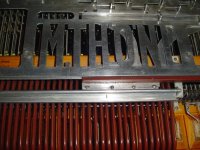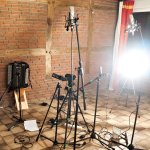Well, I now had some more time and utilized the remainders of the day of the big plasma ball in the sky for lighting. Looking at the results, the main camera could have been sharper, perhaps using the imaging mode "Portrait" on this camera was a mistake: I suspect that it tried smoothing the 190 pimples on the bass side of my accordion over to make it look younger than its 63 years.
Of course, the combination of available nervosity and concentration and agitation made it such that of the longer footage I took, I ended up just using the first take of the session after all. While there was some artistically nicer material later in the session, getting a reasonably clean version out would have required too much cut&paste to make it a net win.
So now I need to check where to go from here with this piece and try to figure out my own favorite arrangement.
Of course, the combination of available nervosity and concentration and agitation made it such that of the longer footage I took, I ended up just using the first take of the session after all. While there was some artistically nicer material later in the session, getting a reasonably clean version out would have required too much cut&paste to make it a net win.
So now I need to check where to go from here with this piece and try to figure out my own favorite arrangement.


